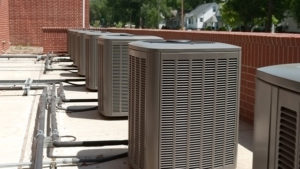Hail guard: Protecting your business equipment

Rooftop equipment is vulnerable to damage from hail.
Most areas of the country experience hailstorms that can cause significant damage to rooftop equipment, severely disrupting your business and costing you time, money or even customers.
A major hailstorm can severely damage fins on your heating, ventilation and air conditioning equipment, rendering it inoperable. That may affect your operations or cause you to cancel functions.
You can take a few steps to help keep your business running smoothly and avoid down time by protecting the equipment that keeps your customers and employees comfortable.
Hail guards serve as a protective shield for your valuable heating, ventilation and air conditioning equipment, as well as roof vents and cooling equipment, which are highly susceptible to hail damage. Large hail can severely damage a unit, but small pellets can cause harm as well. Condenser coil damage, not noticed or addressed, affects the coil’s efficiency, increases your costs and shortens the useful life expectancy of your equipment.
Hail guards come in a variety of sizes and shapes, but most meet the needs for common equipment, such as fans, air conditioners, condenser units, heaters and skylights. Many contractors offer customized options for hard-to-protect items. Look online for hail guards to find more information, resources and various types of guards.
When purchasing hail guards, consider ones that are:
- strong enough to resist hail
- porous enough to allow sufficient and unrestricted air flow
- close enough to the unit to obstruct hail that strikes the roof and bounces up to the unit
- equipped with taut mesh/fabric guards that have sufficient clearance from louvers or fins to prevent hail from deflecting into the fins
In most cases, hail guards warrant the investment when you consider the widespread frequency of hailstorms and the relatively low cost of the guards compared to the down time, efficiency and shortened life or replacement of your valuable HVAC equipment. Contact your HVAC contractor or equipment manufacturer for more solutions to protecting your valuable equipment and keeping your business in business.
By Scott Robinson and Stephen Dale - Loss control blog from Cincinnati Insurance Companies
This loss control information is advisory only. The author assumes no responsibility for management or control of loss control activities. Not all exposures are identified in this article. Contact Anders, Ireland and Marshall for insurance coverage information on your policy.